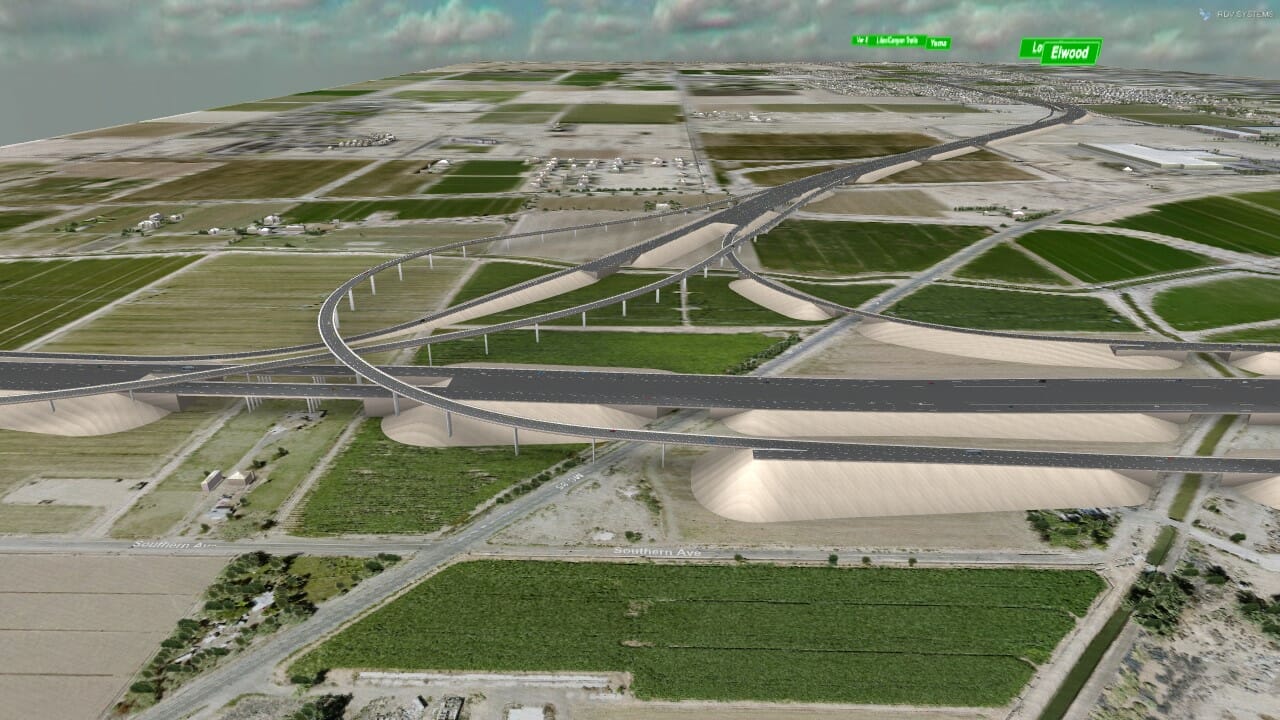When you think about transportation throughout Greater Phoenix, what comes to mind? For some, it might be whatever highway is nearest you — the I-10, Loop 101, Loop 303, or I-17. Or, maybe it’s the light rail or other Valley Metro public transit systems. And, it’s not beyond the scope of reality to let out a resigned sigh when thinking about it. Because, if we’re being honest, traffic and gridlock are issues almost any metropolitan city faces — especially for rapidly growing regions like the Valley of the Sun.
READ ALSO: Loop 303 corridor becomes global center for development
No matter where you fall on the Metro Phoenix transportation infrastructure spectrum — yay to nay — it’s important to know that your city, government and educational leaders are working to expand and improve the landscape. In addition to investing a substantial amount of dollars into new transportation avenues, ongoing research to fine-tune existing infrastructure is also taking place. The result of these collective measures is adding to an already competitive and lucrative global economy — not only in Greater Phoenix, but throughout the entire state.
The legislative lane
Announced in March, the bipartisan Infrastructure Investment and Job Act (IIJA) championed by Senator Kyrsten Sinema and shaped by Senator Mark Kelly, provides $2.9 billion in transportation grants available to Arizona transportation projects.

“The IIJA is an unconventional funding amount for transportation at the federal level that will significantly impact our transportation system,” says Alyssa Ryan, assistant director of the Center for Applied Transportation Sciences (CATS). “IIJA will create more jobs in transportation, from planning to new construction of infrastructure. It will also increase projects in underserved communities, create more transportation solutions that consider climate change and result in more innovative and intelligent transportation systems that will move people more safely and efficiently.”
The IIJA is designed to make it easier for Arizona cities and towns to apply for grants by rolling three projects into one application: The National Infrastructure Project Assistance (MEGA) program, the Infrastructure for Rebuilding America (INFRA) program and the Rural Surface Transportation Grant Program (RURAL).
Phoenix transportation congestion suggestions
“Arizona is the 11th-most urbanized state and Greater Phoenix is one of the fastest-growing regions in the country, accounting for roughly 70% of the state’s population, jobs and economic output,” explains Chris Camacho, president and CEO of Greater Phoenix Economic Council (GPEC). “Growth means more strain on our transportation system — slowing down our commutes, supply lines and everyday lives.”
If you’re curious about the current quantifiable strain brought on by a booming population increase, The American Society of Civil Engineers (ASCE) gave Arizona roads a grade of D+ in 2020, according to Ryan. “We need to continue to fund innovative ways to manage demand,” she says, “and prioritize investments that preserve and maintain our transportation system, to raise our grade and provide safer, more resilient, efficient systems for Arizonans.”
As for innovation in infrastructure, CATS, housed at the University of Arizona (UArizona) is at the forefront, uniting government agencies, private companies and educational institutions to improve transportation systems, with a particular focus on smart cities.

“Our goal is to try to reduce congestion and improve safety,” explains Yao-Jan Wu, center director and associate professor of civil and architectural engineering and mechanics at UArizona.
Wu goes on to note that CATS has two main objectives to help achieve the goals mentioned above: Transition System Management Operations (TSMO) and Mobility on Demand (MOD). “These are the two major strategies to improve traffic from the traffic operation and the demand management sides,” he says.
Much of CATS’ strategy focuses not so much on remedying infrastructure problems by adding new roads but rather concentrating on how to improve existing ones.
“Building roadways will not solve congestion issues, but traditionally people think, ‘It’s so congested. Why not build or expand a roadway?’” Wu says.
CATS invites a different perspective, according to Wu, by encouraging people to think about the positive impact that can occur by improving existing roads. “Without changing the capacity, without multi-billion dollar investment in infrastructure, let’s improve signal timing, how people drive or change people’s minds to choose another mode of transportation,” he says.
Planes, trains and automobiles
Of course, investing in Metro Phoenix transportation and infrastructure isn’t relegated solely to roads.
“The Phoenix Airport System connects the region both nationally and internationally to 142 destinations, allowing businesses to operate at a larger scale and reach,” Camacho says. “Its total economic impact within the Greater Phoenix metropolitan area is in excess of $38.7 billion annually.”
These connections, Camacho says, are crucial in attracting businesses at an international level. “As a Southwest hub, The Phoenix Harbor International Airport has the capacity to ship and receive more than 900 tons of air cargo every day, keeping supply lines open for the diversified Greater Phoenix industry sector” he explains, “and because it is financially self-sustaining, public expense is limited.”
Phoenix-Mesa Gateway Airport, SkyBridge also provides an attractive logistics hub as the nation’s first international inland air cargo hub housing Mexican and U.S. customs. Businesses seeking to streamline shipments to and from Mexico can take advantage of frequent cargo flights (projected to reach 10,000 by 2036).

As Arizona’s roadways and airports garner further interest from companies far and wide, so does another key transportation outlet. “Growth has attracted major new railway interest and is building new economies around our regional airports,” says David Krumwiede, senior executive vice president for Lincoln Property Company (LPC). “LPC alone has a number of Class-A developments that count on regional airport adjacency for their tenant attraction and retention,” he says.
Global economy green light
A two-lane blacktop, while charming in a small-town setting, does not an economic global economy make. Even when Phoenix Metro was in its humble beginnings, its city, economic and business leaders had the forethought and ingenuity to envision a future when a robust infrastructure would be needed to support burgeoning economic development.
“This infrastructure has consistently proven attractive to businesses locating to Greater Phoenix, with nearly nine out of ten jobs located through the GPEC pipeline doing so within two miles of a freeway corridor,” Camacho says. “Continued investment means that the infrastructure we have in place can expand proportionately based on demand and that we can proactively take measures to reduce the strain on the region’s transportation ecosystem — intentional planning mitigates the unintended consequences of growth.”
Krumwiede points to corridors like the Loops 101, 202 and 303 — with the addition of new freeways — as attracting national and international companies to the Valley, “adding thousands of high-paying jobs and expanding our economic diversification and stability,” he says, further noting “a surge of manufacturing and e-commerce employers locating to our state, and one of the main drivers of that is our commitment to our transportation infrastructure.”
Then there’s the I-10, a long-time staple of transportation and key economic driver linking us to the Los Angeles and Long Beach ports, providing what Krumwiede says is “a convenient alternative to the high-priced and oversaturated Inland Empire warehouse and distribution market.”
In the West Valley, industrial activity is hotter than ever along the 303, with notable transplants such as the Taiwan Semiconductor Manufacturing Company’s $12 billion manufacturing facility (the largest land deal to date in Arizona).
But industrial, advanced manufacturing, e-commerce and logistics-based businesses aren’t the only markets making a move due to rich transportation offerings. Recently, an article published by Arizona State University (ASU) reported that biomedical companies are choosing Phoenix in part because of its “outstanding public transportation.”
Roadwork ahead
As a variety of industries make their way to the Valley, vigilance in infrastructure investments will become increasingly crucial.
“We need to continue to fund transportation routes like these, and absolutely need to support Prop 400 in Nov., which will extend our half-cent sales tax for transportation,” Krumwiede says. “If we can combine this with continued utility infrastructure development for things like power, water and sewer, Phoenix will remain extremely competitive within the region and even the nation.”
Proposition 400, initially approved by voters in 2004, extended the half-cent sales tax for transportation by 20 years and will expire in 2025. According to the Land Economics Society (LAI), the Proposition extension is “expected to raise about $19 billion over the 25-years the tax. The overall plan including expected federal and other funds is over $36 billion.”
If passed, the Prop 400 extension will continue to aid in transportation upgrades supporting major development/population centers such as the Loop 303, enabling “35 miles of improvements” along the corridor, according to the Maricopa Association of Governments (MAG). As Maricopa County’s population continues to rise, measures like Prop 400 are crucial to fulfilling escalating transportation infrastructure demands across not only the West Valley, but the entire Greater Phoenix Metro.
Adds Wu, “We actually need to research new technologies to see how we can use them to solve our daily traffic issues or transportation issues. That’s why with research grants from local and federal sources, we are able to continuously investigate all these issues. With this [IIJA] grant, we actually can help our system become safer and more efficient.”




